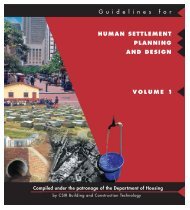Chapter 3 - CSIR
Chapter 3 - CSIR
Chapter 3 - CSIR
Create successful ePaper yourself
Turn your PDF publications into a flip-book with our unique Google optimized e-Paper software.
FEMTOSECONDSCIENCE:THENEXTFRONTIERFEMTOSECOND LASER SCIENCE is oneof the fastest growing research fields in laserscience today. It is a field of research andtechnology utilising state-of-the-art lasersystems delivering extremely short pulses withhigh peak intensities, in particular pulses inthe femtosecond regime. Over the past tenyears, these lasers have gradually becomecommercially-available, which has resulted inan upsurge in this field of research. One femtosecond(fs) is equal to one millionth of abillionth of a second (10 -15 s). This is an extremelyshort unit of time: small moleculestypically take a few hundred femtoseconds tocomplete one vibration. This is exactly one ofthe advantages of such short pulses; they areso short that they can be used to measureextremely fast processes, down to thefemtosecond regime where no other timeresolvedtechniques exist.In 2007, the <strong>CSIR</strong> established a femtosecondresearch group; and a versatile amplifiedfemtosecond laser system was installed.The <strong>CSIR</strong> uses the characteristic of the shorttemporal duration of femtosecond laserpulses to measure extremely fast biologicaland chemical processes. A technique calledpump probe spectroscopy is used to measureabsorption changes in liquid samples as fastas 150 femtoseconds, a first of its kind inAfrica. Another major advantage of thistechnology is the extremely high peakpowers that are obtained using these shortpulses – allowing for a wide variety ofinteresting and novel applications.For example, the technique of laser inducedbreakdown spectroscopy, which is an establishedlaser spectroscopic technique for measuringtrace quantities of elements in anymaterial down to the parts-per-million (ppm)level in real time and without sample preparation,is made even more sensitive and accuratewhen using femtosecond laser pulses.One of the many advantages of this laser isthe low mass ablation rates making precisionsampling and depth profiling a reality. This iscurrently an active field of research in thefemtosecond laboratory and forms part of aproject for an industrial client, measuringtrace metal concentrations in thin layers as afunction of depth into the layer. This cannotbe performed with other techniques withoutsample preparation and in a non-contactmeasurement setup.Other active fields of research include laserionisation time of flight mass spectroscopy,laser ablation and micromachining, and laserpulse shaping and diagnostics. This researchis currently being undertaken in a combinedeffort to make a long-term impact in thisexciting field and in particular in coherentcontrol, but also to make an impact in theshort-term by applying this technology tospecific industrial problems.Using femtosecond laser techniques, one canactually control chemical and biological reactions,a technique called coherent control.This is made possible through the couplingbetween frequency and time by the Heisenberguncertainty principle. Applying this principleto, for example, 100 femtosecond laserpulses implies that these pulses must have awavelength bandwidth or ‘spread’ of about10 nanometres; entirely different from typicallaser sources that are monochromatic (verynarrow wavelength spread). This characteristicof femtosecond lasers makes it possible toexcite molecules at exactly the same time butinto adjacent excited energy levels, which iscalled a coherent excitation or wavepacket.Such a wavepacket after excitation coherentlyvibrates in the excited state and maythen be manipulated further into an ionisedstate, a dissociating state or some otherprocess can be initiated. By changing thelaser pulse parameters and timing of subsequentpulses it actually becomes possible tocontrol molecular processes. In principle,this means that chemical reactions may becontrolled, for example a reaction that canproduce either product A or B may becontrolled to produce selectively more ofA or more of B by simply changing certainlaser parameters in real time. For example,in a chemical deposition process generatingthin layers of material, the deposition processcould possibly be improved in real time bycoherent control techniques.According to <strong>CSIR</strong> Interim Group Executive,Dr Thulani Dlamini, “The <strong>CSIR</strong> has seen thepotential of this new technology and intendsmaking an impact by becoming a worldleader in niche application areas of femtosecondscience. Our research is alreadylooking at building an understanding of industrially-relevantchemical reactions andnovel approaches to materials processing.”Enquiries:Dr Anton du Plessisadplessis2@csir.co.zaS C I E N C E S C O P E J A N U A R Y 2 0 0 979
















